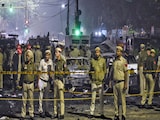Prime Minister Narendra Modi has said, “Ganga flows from Bihar to Bengal”. After the mammoth victory in Bengal the Prime Minister, speaking at the Delhi party headquarters, declared that now the “jungle raj of Bengal would also be over”.
Understandably, the BJP was in a pensive state in West Bengal when its national leadership requested a membership drive of one crore but was unable to gather more than a few lakh candidates. Additionally, there were internal conflicts among state authorities. At that point, there was hope that Mamata would be overthrown; this was followed by the outcome of the Bihar election and the Prime Minister's victory speech. It's natural for BJP cadres in West Bengal to thus feel re-energised.
However, the primary concern is whether West Bengal will also deliver what Bihar gave to the NDA, disproving the exit polls. Nothing is impossible in politics, as Napoleon once stated. Even so, he still had to deal with Waterloo. Therefore, despite all of the BJP's optimistic rhetoric, the West Bengal BJP will face several challenges.
Narendra Modi has strong brand equity. But, there is still much work to be done in terms of spreading that value door-to-door, mobilising voters, and securing their votes at the ballot.
There are ten reasons why BJP may not have it easy in Bihar.
One, Mamata Banerjee is not a Tejashwi or a Rahul. Despite being the leading opposition figure in the country, Rahul was hardly noticeable in Bihar during this election. He was not present at the first SIR press conference held in Bihar by the Election Commission. Yet, he was the one who repeatedly brought attention to the “vote chori” issue. Regarding this, however, he held more press conferences outside Bihar - in Delhi and other state capitals - than in Bihar itself.
Two, Tejashwi Yadav and Lalu Yadav differed greatly. The old-fashioned Lalu used to be accessible to even the most isolated individuals, and anyone could visit his home. In fact, this author, too, once went there. Tejashwi, on the other hand, has a different way of functioning, not to mention the disputes among siblings and other issues plaguing the family.
Three, Rahul and Tejashwi made several concessions for one another. While Tejashwi announced Rahul Gandhi's candidacy for Prime Minister in the 2029 election, the latter took a long time to return that gensture. Nevertheless, he did finally announce Tejashwi Yadav's candidacy for Chief Minister in this Bihar election. In a way, he outsourced Tejashwi to handle the Bihar project.
Four, Rahul made a disastrous attempt to unite the people of Bihar through the SIR issue, alleging that the BJP was stealing votes and that fraudulent voters should be eliminated. Even Tejashwi did not take these problems very seriously. As a result, Tejashwi and the Congress had different opinions about how aggressively the issues should be pursued.
However, Mamata in West Bengal has been extremely hostile towards SIR from the very beginning. Instead of attending press conferences, she called meetings with party workers and state election commission officers to fight this in each district and block, file complaints, and submit them to the Election Commission. Thus, Mamata's approach differs sharply from Rahul Gandhi's.
Five, as Chief Minister and the head of the ruling party, Mamata addressed the matter and launched an aggressive campaign against Delhi. West Bengal has always been aggressive in its opposition to the Central government. Mamata is still carrying that radicalism and waging an anti-Delhi, anti-BJP, and anti-Modi campaign, in much the same manner as Tejashwi did in Bihar, against Nitish. Mamata's anti-Delhi campaign has so far been successful, while Tejashwi's anti-BJP campaign was not. Because of this, even though the BJP is the opposition party in West Bengal, the election appears to be between Modi and Mamata, with the latter sticking to her anti-Delhi stance and showcasing herself as a true Bengali.
Six, when it comes to Hinduism and Hindutva, Mamata may have 30% support from Muslims, but she is unlikely to make the mistake of ignoring the the Hindus. She has highlighted issues like the Jagannath Temple and Kali Puja, which she has long been associated with.
Seven, in many places, the Muslim vote was affected by the Owaisi factor. While some Muslims speak Urdu and others Bihari, the majority in West Bengal are Bengali Muslims. They are as much Bengali as they are Muslim, and Mamata is the only person who maintains their Bengali identity. This time, Owaisi stated that his party would consider Uttar Pradesh after Bihar, but not Bengal. This is perhaps because despite having the backing of the Left and Congress earlier, Owaisi sees no change in Bengal. Also, a part of the ISF's Furfura Sharif shares an understanding with Mamata.
Eight, Mamata consistently participates in projects like Sastha Sathi, Kanyashree, and many others, to woo the women voters, just like Nitish Kumar did in Bihar. It is also expected that she will announce some fresh schemes in February.
Nine, Mamata is vigilant. There may be some differences in how she and Abhishek Banerjee operate, but when it actually comes to elections, Abhishek focuses on the organisational side and Mamata handled governance issues. Together, they function like an umbrella.
Ten, the BJP suffers from poor organisational capacity in West Bengal, and changing that ground reality needs time and work.
Thus, it is won't be easy for the BJP to defeat the Trinamool Congress, though it's not impossible. The BJP needs to successfully deliver its message door to door to really make its mark in West Bengal. It won't be a piece of cake, surely.
(The author is Consultant Editor, NDTV)
Disclaimer: These are the personal opinions of the author















